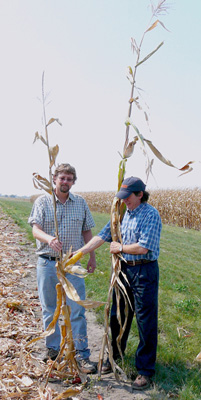Tropical maize could prove to be a very attractive dedicated energy crop with some very desirable characteristics, according to research being done at the University of Illinois.
When University of Illinois crop scientist Fred Below began growing tropical maize, the form of corn grown in the tropics, he was looking for novel genes for the utilization of nitrogen fertilizer and was hoping to discover information that could be useful to American corn producers.
 Now, however, it appears that maize itself may prove to be the ultimate U.S. biofuels crop. Early research results show that tropical maize, when grown in the Midwest, requires few crop inputs such as nitrogen fertilizer, chiefly because it does not produce any ears. It also is easier for farmers to integrate into their current operations than some other dedicated energy crops because it can be easily rotated with corn or soybeans, and can be planted, cultivated and harvested with the same equipment U.S. farmers already have. Finally, tropical maize stalks are believed to require less processing than corn grain, corn stover, switchgrass, Miscanthus giganteus and the scores of other plants now being studied for biofuel production.
Now, however, it appears that maize itself may prove to be the ultimate U.S. biofuels crop. Early research results show that tropical maize, when grown in the Midwest, requires few crop inputs such as nitrogen fertilizer, chiefly because it does not produce any ears. It also is easier for farmers to integrate into their current operations than some other dedicated energy crops because it can be easily rotated with corn or soybeans, and can be planted, cultivated and harvested with the same equipment U.S. farmers already have. Finally, tropical maize stalks are believed to require less processing than corn grain, corn stover, switchgrass, Miscanthus giganteus and the scores of other plants now being studied for biofuel production.
What it does produce, straight from the field with no processing, is 25 percent or more sugar in the forms of sucrose, fructose and glucose.
Below says that tropical maize could become the “sugarcane of the Midwest” because, like sugarcane, it produces lots of sugar without a high requirement for nitrogen fertilizer, and this sugar can be fermented to alcohol without the middle steps required by high-starch and cellulosic crops.
Pictured with some of the tropical maize produced on the research farm in Illinois are Below (right) and doctoral candidate Mike Vincent.

